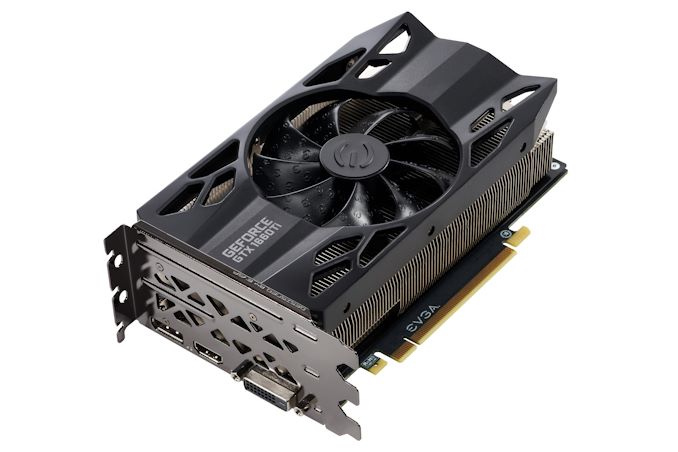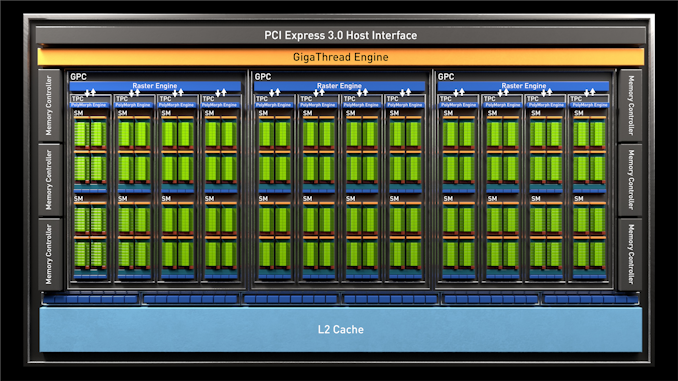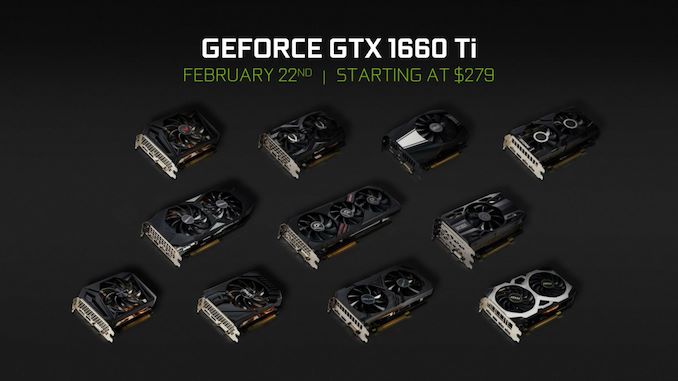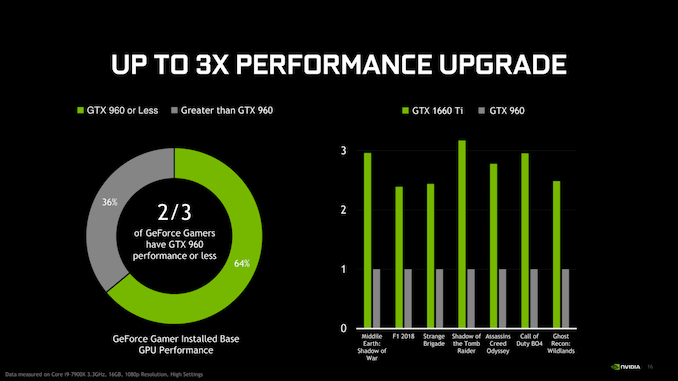The NVIDIA GeForce GTX 1660 Ti Review, Feat. EVGA XC GAMING: Turing Sheds RTX for the Mainstream Market
by Ryan Smith & Nate Oh on February 22, 2019 9:00 AM EST
When NVIDIA put their plans for their consumer Turing video cards into motion, the company bet big, and in more ways than one. In the first sense, NVIDIA dedicated whole logical blocks to brand-new graphics and compute features – ray tracing and tensor core compute – and they would need to sell developers and consumers alike on the value of these features, something that is no easy task. In the second sense however, NVIDIA also bet big on GPU die size: these new features would take up a lot of space on the 12nm FinFET process they’d be using.
The end result is that all of the Turing chips we’ve seen thus far, from TU102 to TU106, are monsters in size; even TU106 is 445mm2, never mind the flagship TU102. And while the full economic consequences that go with that decision are NVIDIA’s to bear, for the first year or so of Turing’s life, all of that die space that is driving up NVIDIA’s costs isn’t going to contribute to improving NVIDIA’s performance in traditional games; it’s a value-added feature. Which is all workable for NVIDIA in the high-end market where they are unchallenged and can essentially dictate video card prices, but it’s another matter entirely once you start approaching the mid-range, where the AMD competition is alive and well.
Consequently, in preparing for their cheaper, sub-$300 Turing cards, NVIDIA had to make a decision: do they keep the RT and tensor cores in order to offer these features across the line – at a literal cost to both consumers and NVIDIA – or do they drop these features in order to make a leaner, more competitive chip? As it turns out, NVIDIA has opted for the latter, producing a new Turing GPU that is leaner and meaner than anything that’s come before it, but also very different from its predecessors for this reason.
That GPU is TU116, and it’s part of what will undoubtedly become a new sub-family of Turing GPUs for NVIDIA as the company starts rolling out Turing into the lower half of the video card market. Kicking things off in turn for this new GPU is NVIDIA’s latest video card, the GeForce GTX 1660 Ti. Launching today at $279, it’s destined to replace NVIDIA’s GTX 1060 6GB in the market and is NVIDIA’s new challenger for the mainstream video card market.
| NVIDIA GeForce Specification Comparison | ||||||
| GTX 1660 Ti | RTX 2060 Founders Edition | GTX 1060 6GB (GDDR5) | RTX 2070 | |||
| CUDA Cores | 1536 | 1920 | 1280 | 2304 | ||
| ROPs | 48 | 48 | 48 | 64 | ||
| Core Clock | 1500MHz | 1365MHz | 1506MHz | 1410MHz | ||
| Boost Clock | 1770MHz | 1680MHz | 1708MHz | 1620MHz FE: 1710MHz |
||
| Memory Clock | 12Gbps GDDR6 | 14Gbps GDDR6 | 8Gbps GDDR5 | 14Gbps GDDR6 | ||
| Memory Bus Width | 192-bit | 192-bit | 192-bit | 256-bit | ||
| VRAM | 6GB | 6GB | 6GB | 8GB | ||
| Single Precision Perf. | 5.5 TFLOPS | 6.5 TFLOPS | 4.4 TFLOPs | 7.5 TFLOPs FE: 7.9 TFLOPS |
||
| "RTX-OPS" | N/A | 37T | N/A | 45T | ||
| SLI Support | No | No | No | No | ||
| TDP | 120W | 160W | 120W | 175W FE: 185W |
||
| GPU | TU116 (284 mm2) |
TU106 (445 mm2) |
GP106 (200 mm2) |
TU106 | ||
| Transistor Count | 6.6B | 10.8B | 4.4B | 10.8B | ||
| Architecture | Turing | Turing | Pascal | Turing | ||
| Manufacturing Process | TSMC 12nm "FFN" | TSMC 12nm "FFN" | TSMC 16nm | TSMC 12nm "FFN" | ||
| Launch Date | 2/22/2019 | 1/15/2019 | 7/19/2016 | 10/17/2018 | ||
| Launch Price | $279 | $349 | MSRP: $249 FE: $299 |
MSRP: $499 FE: $599 |
||
We’ll go into the full ramifications of what NVIDIA has (and hasn’t) taken out of TU116 on the next page, but at a high level it’s still every bit a Turing GPU, save the RTX functionality (RT and tensor cores). This means that it has the same core architecture in its SMs, and is directly comparable to the likes of the RTX 2060. Or to flip things around the other direction, versus the older Pascal and Maxwell-based video cards, it comes with all of Turing’s performance and efficiency benefits for traditional graphics workloads.
Compared to RTX 2060 then, the GTX 1660 Ti is actually rather similar. For this fully-enabled TU116 card, NVIDIA has dialed back on the number of SMs a bit, going from 30 to 24, and memory clockspeeds have dropped as well, from 14Gbps to 12Gbps. But past that, the two cards are closer in specifications than we might expect to see for a $70 price tag difference, especially as NVIDIA has kept the 6GB of GDDR6 on a 192-bit memory bus. In an added quirk, the GTX 1660 Ti actually has a slightly higher average boost clockspeed than the RTX 2060, with its 1770Mhz clockspeed giving it a 5% edge here.
The end result is that, on paper, the GTX 1660 Ti actually has a bit more ROP pixel pushing power than its bigger sibling thanks to that 5% boost clock advantage. However the drop in the SM count definitely hits compute and texture performance, where GTX 1660 Ti is going to deliver around 85% of RTX 2060’s compute and shading throughput. Or to frame things in reference to the GTX 1060 6GB it replaces, on the new card offers around 24% more compute/shader throughput (before taking architecture into account), a much smaller 4% increase in ROP throughput, and a very sizable 50% increase in memory bandwidth.
Speaking of memory bandwidth, NVIDIA’s continued use of a 192-bit memory bus in this segment continues to be a somewhat vexing choice since it leads to such odd memory amounts. I’ll fully admit I would have liked to have seen 8GB here, but then that was the case for RTX 2060 as well. The flip side being that at least they aren’t trying to ship a card with just a 128-bit memory bus, as was the case for GTX 960. This puts GTX 1660 Ti in an interesting spot in terms of memory bandwidth, since it’s benefitting from the jump to GDDR6; if you thought the GTX 1060 could use a little more memory bandwidth, GTX 1660 Ti gets it in spades. This has also allowed NVIDIA to opt for cheaper 12Gbps GDDR6 VRAM, marking the first time we’ve seen this in any video card.
Finally, taking a look at power consumption, we see that NVIDIA is going to be holding the line at 120W, which is the same TDP as the GTX 1060 6GB. This is notable because all of the other Turing cards to date have had higher TDPs than the cards they replace, leading to a broad case of generational TDP inflation. Of course we’ll see what actual power consumption is like in our testing, but right off the bat NVIDIA is setting up GTX 1660 Ti to be noticeably more power efficient than the RTX 20 series cards.
Wait, It's a GTX Card?
Along with the new TU11x family of GPUs, for this launch NVIDIA is also creating a new family of video cards: the GeForce GTX 16 series. With GTX 1660 Ti and its obligatory siblings lacking support for NVIDIA’s RTX family of features, the company has decided to clarify their product naming in only a way that NVIDIA can. The end result is that along with keeping the GTX prefix rather than RTX – since these parts obviously lack RTX functionality – the company is also giving them a lower series number. Overall it’s probably for the best that NVIDIA didn’t include these cards with the 20 series, least we get another GeForce 4 situation.
But on the flip side, the number “16” also doesn’t have any great meaning to it; other than not being “20” the number is somewhat arbitrary. According to NVIDIA, they essentially picked it because they wanted a number close to 20 to indicate that the new GPU is very close in functionality and performance to TU10x, and thus “16” instead of “11” or the like. Of course I’m not sure calling it the GTX 1660 Ti is doing anyone any favors when the next card up is the RTX 2060 (sans Ti), but there’s none the less a somewhat clear numerical progression here – and at least for the moment, one not based on memory capacity.
Price, Product Positioning, & The Competition
Moving on, unlike NVIDIA’s other Turing card launches up until now – and unlike the GTX 1060 6GB – the GTX 1660 Ti is not getting a reference card release. Instead this is a pure virtual launch, as NVIDIA calls it, meaning all the cards hitting the shelves are customized vendor cards. Traditionally these launches tend to be closer to semi-custom cards – partners tend to use NVIDIA’s internal reference board design or their first cards – so we’ll have to see what pops up over the coming weeks and months. For now then, this means we’re going to see a lot of single and dual-fan cards, similar to the kinds of designs used for a lot of the GTX 1060 cards and some of the RTX 2070 cards.
Another constant across the Turing family has been price inflation, and the GTX 1660 Ti is no exception. With a launch price of $279, the new card is launching at $30 above the GTX 1060 6GB it replaces. This is a lot better than the $349 that NVIDIA wants for the RTX 2060, but in case anyone thought that the $250 price tag of the GTX 1060 was a fluke, then it’s clear that sub-$300 is the new norm for xx60 cards, and not sub-$200 as the GTX 960 flirted with. It’s also worth noting that NVIDIA won’t be launching with any bundles here; neither the RTX Game On bundle nor the GTX 1060 Fortnite bundles will be in play here, so what you see is what you get.
In terms of positioning against their own cards, NVIDIA is rolling out the GTX 1660 Ti as the successor to the GTX 1060 6GB, the latter of which are becoming increasingly rare in the market as NVIDIA’s unplanned Pascal stockpile is finally drawn down. So the GTX 1660 Ti and GTX 1060 won’t be sharing space on store shelves for long. However like the other Turing cards, the GTX 1660 Ti is not a true generational successor to the GTX 1060; at roughly 36% faster, NVIDIA is not expecting anyone to upgrade from their mid-range Pascal card to this. Instead, NVIDIA’s marketing efforts are going to be heavily focused on enticing GTX 960 users, who are a further generation back, to finally upgrade. In that respect the GTX 1660 Ti has a very large performance advantage, but this may be a tough sell since the GTX 960 launched at a much cheaper $199 price point.
As for AMD, the launch of the GTX 1660 Ti finally puts a Turing card in competition with their Polaris cards, particularly the $279 Radeon RX 590, a fight that the Radeon cannot win. While AMD hasn’t announced any price changes for the RX 590 at this time, AMD will have little choice but to bring it down in price.
Instead, AMD’s competitor for the GTX 1660 Ti looks like it will be the Radeon RX Vega 56. The company sent word last night that they are continuing to work with partners to offer lower promotional prices on the card, including a single model that was available for $279, but as of press time has since sold out. Notably, AMD is asserting that this is not a price drop, so there’s an unusual bit of fence sitting here; the company may be waiting to see what actual, retail GTX 1660 Ti card prices end up like. So I’m not wholly convinced we’re going to see too many $279 Vega 56 cards, but we’ll see. If nothing else, AMD’s Raise the Game Bundle is being offered, giving them an edge over NVIDIA in terms of pack-in games.
| Q1 2019 GPU Pricing Comparison | |||||
| AMD | Price | NVIDIA | |||
| Radeon RX Vega 64 | $499 | GeForce RTX 2070 | |||
| $349 | GeForce RTX 2060 | ||||
| $329 | GeForce GTX 1070 | ||||
| Radeon RX Vega 56* Radeon RX 590 |
$279 | GeForce GTX 1660 Ti | |||
| $249 | GeForce GTX 1060 6GB (1280 cores) |
||||
| Radeon RX 580 (8GB) | $179/$189 | GeForce GTX 1060 3GB (1152 cores) |
|||













157 Comments
View All Comments
CiccioB - Tuesday, March 5, 2019 - link
Kid, as I said you lack basic intelligence to recognize when you are just arguing about nothing.The number I'm using are those published by AMD and nvidia in their quarter results.
Now, if you are asking me the links for those reports it means you don't have the minimum idea of what I'm talking about AND you cannot do a simple search with Google.
So I stand my "insults": you have not the intelligence to argue about this simple topic, so stop writing completely on this site that has much better readers than you and is not gaining anything by your presence.
Korguz - Tuesday, March 5, 2019 - link
ahh here are the insults and name calling... and you are calling me a kid ??i can, and have done a simple google search.. BUT, i would like to see the SAME info YOU are looking at as well, but again.. i guess that is just too much to ask of you, is it wrong to want to be able to compare the same facts as you are looking at ? i guess so.. cause you STILL refuse to post where you get your facts and info from, i sure dont have the time so spend who knows how long to do a simple google search...
by standing by our insults, just shows YOU are the child here.. NOT me, as only CHILDREN resort to insults and name calling...
as i said in my reply farther down :
you refuse post links, OR mention your sources, simply because YOU DONT HAVE ANY.. most of what you post.. is probably made up, or rumor, if AT posted things like you do, with no sources, you probably would be all over them asking for links, proof and the like... and by YOUR previous posts, all of your info is made up and false..
maybe YOU should stop posting your info and facts from rumor sites, and learn to talk with some intelligence your self.
Qasar - Tuesday, March 5, 2019 - link
sorry CiccioB, but i agree with Korguz.. i have tried to find the " facts " on some of the things you have posted in this thread.. and i cant find them.. i also would like to know where you get your " opinions " from.CiccioB - Wednesday, March 6, 2019 - link
Quarter results!It's not really difficult to find them..
Try "AMD quarter results" and then "nvidia quarter results" in Google search engine and.. voilà, les jeux sont faits. Two clicks and you can read them. Back some years if you want,so you can have a history of what has happened during the last years apart the useless comments by fanboys you find on forums.
Now, if you have further problems at understanding all those tables and numbers or you do not know what is a gross margin vs a net income, then, you can't come here and argue I have no facts. It's you that can't understand publicly available data.
So if you want already chewed numbers that someone has interpreted for you, you can read them here:
https://www.anandtech.com/show/13917/amd-earnings-...
I wonder what you were looking for for not finding those numbers that have been commented by every site that is about technology.
@Korguz
You a re definitely a kid. You surely do not scare me with all those nonsense you write when the solution for YOUR problem (not mine) was simply to read more and write less.
Korguz - Thursday, March 7, 2019 - link
CiccioB you are hilarious !!!did you look up the word hypnotize, to see what it means, and how it even relates to this ? as, and i quote YOU " Or you may try to hypnotize the third view " what does that even mean ??
i KNEW the ONLY link you would mention.. is the EASY one to find.
BUT... what about all of these LIES :
" GCN was dead at its launch time"
" 9 years of discounted sell are not enough to show you that GCN simply started as half a generation old architecture to end as a generation obsolete one? "
" that is Hawaii, which was so discounted "
" starting with Fiji and it's monster BOM cost "
" AMD is selling Ryzen CPU at a discount like GPUs and both have a 0.2% net margin "
" One is that AMD is discounting every product (GPU and CPU) to a ridiculous margin "
" a "panic plan" that required about 3 years to create the chips. 3 years ago they already know that they would have panicked at the RTX cards launch and so they made the RT-less chip as well "
i did the simple google search for the above comments from you, as well as variations.. and guess what.. NOTHING comes up. THESE are the links i would like you to provide, as i cant find any of these LIES . so " It's you that can't understand publicly available data. " the above quotes, are not publicly available data, even your sacred " simple google search " cant find them.
lastly.. your insults and name calling ( and the fact that you stand by them ).. the only people i hear things like this from.. are from my friends and coworkers TEENAGE CHILDREN. NOT adults.. adults don't resort to things like this, at least the ones that i know... this alone.. shows how immature and childish you really are... i am pretty sure.. you WILL never post links to 98% of the LIES, RUMORS, or your personal speculation, and opinions, because of the simple fact, you just CAN'T, as your sources for all this... simply doesn't exist.
when you are able to reply to people with out having to resort to name calling and insults, then maybe you might be taken seriously. till then... you are nothing but a lying, immature child, who needs to grow up, and learn how to talk to other people in a respectful manner... maybe YOU should take your OWN advice, and simply read more and write less. Have a good day.
D. Lister - Saturday, February 23, 2019 - link
@CiccioBNavi will still be GCN unfortunately.
CiccioB - Monday, February 25, 2019 - link
If so don't cry if price will remain high (if not higher) for the next 3 years.We already know why.
Simplex - Friday, February 22, 2019 - link
"EVGA Precision remains some of the best overclocking software on the market."Better than MSI Afterburner?
Ryan Smith - Friday, February 22, 2019 - link
I consider both of them to be in the same tier, for what it's worth.Rudde - Friday, February 22, 2019 - link
In what way does 12nm FFN improve over 16nm? The transistor density is roughly the same, the frequencies see little to no improvement and the power-efficiency has only seen small improvements. Worse yet, the space used per SM has gotten worse. I do know that Turing brings architectural improvements, but are they at the cost of die space? Seems odd that Nvidia wouldn't care about die area when their flagships are huge chips that would benefit from a more dense architecture.Or could it be that Turing adds some kind of (sparse) logic that they haven't mentioned?